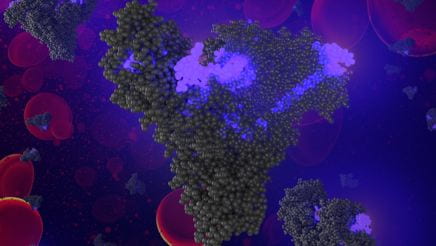For years, drug developers have tried, but failed, to build the perfect biological Trojan horse. Now, a new approach that disguises chemotherapeutic drugs as fat stands to outsmart, penetrate and destroy tumors. For the first time, a team of Northwestern researchers, led by Chemistry of Life Processes Institute member Nathan Gianneschi, and collaborators from the University of California, San Diego have developed a highly effective method that delivers a powerful new anticancer drug, hidden inside human serum albumin (HSA), one of the most abundant proteins found in the blood, directly into tumors. Once inside, the drug activates and suppresses tumor growth with very low toxicity to normal tissues at much higher concentrations than two leading approved chemotherapy drugs.
The results, which elucidate the design, synthesis and efficacy of this new carrier strategy for small molecule drugs, is based on exploiting the natural interactions between long-chain fatty acids (LCFAs) and HSA. The study was published today (July 18) in the Journal of the American Chemical Society (JACS).
One of the key functions of HSA is to carry molecules, such as fats, to different parts of the body. LCFAs consist of a molecular chain with a hydrophilic head and a long hydrophobic tail. The heart-shaped HSA protein contains several channels where chains of water-hating fatty acids can attach and hide with their hydrophilic heads buried inside. Like a magnet, the channels with hydrophobic walls and hydrophilic bottoms, attract and store the fats, enabling safe transport throughout the circulatory system and into tissues.
The body’s cellular receptors recognize the fats and proteins supplied by HSA and allow them inside. Fast-growing cancer cells ravenously consume nutrients much faster than normal cells.
Several years ago, Gianneschi, the Jacob and Rosaline Cohn Professor of Chemistry in Northwestern’s Weinberg College of Arts and Sciences and professor of biomedical engineering and materials science and engineering in the McCormick School of Engineering and a former Northwestern classmate Paul Bertin, Research Group Leader of Innovation at Elevance Renewable Sciences, hatched an idea.
“Paul called me one day and said, ‘ERS had developed a new type of lipid, a normal fatty acid, but with two carboxylates on either end,’” said Gianneschi. The researchers believed the lipid’s bi-functional structure offered an intriguing new platform for developing a lipidated drug.
“Imagine you have an arm with a hand on it that is able to grab onto the drug,” said Gianneschi. “The chain is like the fat with a hand on both ends: one can grab onto the drug and one can grab onto proteins. The idea is to disguise drugs as fats so that they get into cells and the body is happy to transport them around.”
Researchers have tried for years to attach chemotherapeutic drugs to the single hydrophilic head of traditional LCFAs, but presence of the drug on the head altered the chemistry of the fatty chain making it too unstable to engage securely inside the HSA channel fatty acid binding channels. Instead of putting the drug on the single hydrophilic head of a fat chain, Gianneschi and Cassandra Callmann, a graduate student in Gianneschi’s lab at the time of the study and first author of the paper, developed a new way to attach a taxane anticancer drug to the tail end of the new type of lipid. The technique preserves the head of the LCFA, ensuring a good fit inside the HSA channel enabling the drug to be securely transported without detection into cancer cells.
The experiments showed that the fatty acid with the drug attached to the tail binds HSA in the same places as normal natural fatty acids and that it also preserves the structure of the HSA so it still looks natural to the tumor tissue.
The researchers found five ideal HSA binding sites and tested the new, purified compound they called VTX (the ‘V’ for the Roman numeral five, ‘TX’ for taxane, the drug class of choice here) which consisted of the drug/LCFA combination and HSA. They performed extensive in vivo studies at both UC San Diego and with the assistance of Irawati Kandela, Assistant Director, Research Assistant Professor, Chemistry of Life Processes Institute’s Developmental Therapeutics Core, at Northwestern testing VTX against two FDA-approved paclitaxel formulations over a range of conditions.
What they found astonished them: the new drug eliminated tumors in three different types of cancer: fibrosarcoma, pancreatic cancer and colon cancer.
“It’s like a Trojan horse that looks like a nice little fatty acid, so the receptors see it and invite them in. Then, the drug starts getting metabolized and kills the tumor cells,” said Gianneschi.
Remarkably, the researchers found they could deliver 20 times the dose of paclitaxel with their system, compared to two other paclitaxel-based drugs. But even at such a high quantity, the drug in Gianneschi’s system was still 17 times safer.
Together with ERS, Gianneschi formed Vybyl Biopharma to commercialize the technology and develop new applications to treat a variety of different cancers.
”Commonly used small molecule drugs get into tumors — and other cells,” said Gianneschi. “They are toxic to tumors, but also to humans. Hence, in general, these drugs have horrible side effects. Our goal is to increase the amount that gets into a tumor versus into other cells and tissues. That allows us to dose at much higher quantities without side effects which kills the tumors faster.”
In addition to Gianneshi, Callmann, and Bertin, other authors of the paper include Clare LeGuyader, Spencer Burton, Matthew Thompson, Robert Hennis, Christopher Barback, Niel Henriksen, Warren Chan, Matt Jaremko, Jin Yang, Arnold Garcia, Michael Burkart, Michael Gilson and Jeremiah Momper. The work was supported by ERS, the ARCS Foundation and the Inamori Foundation.
by Lisa La Vallee
Feature image: A modified chemotherapy drug hitches a ride through the bloodstream on human serum albumin.
Nathan Gianneshi is a member of the Chemistry of Life Processes Institute.
